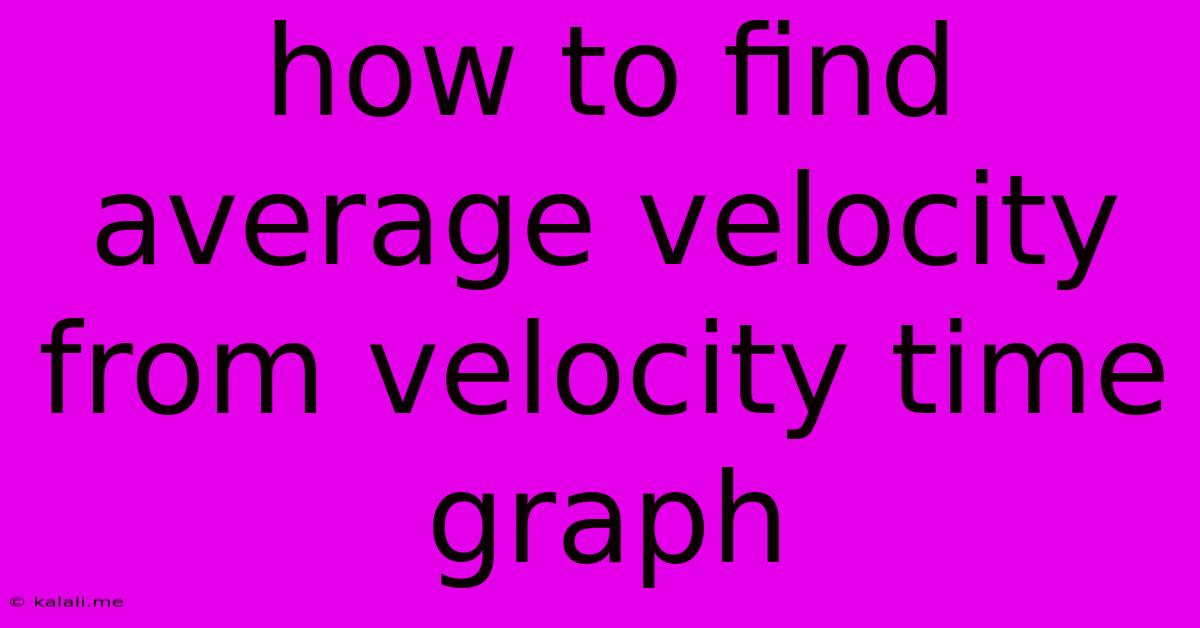How To Find Average Velocity From Velocity Time Graph
Kalali
May 10, 2025 · 3 min read

Table of Contents
How to Find Average Velocity from a Velocity-Time Graph
Finding the average velocity from a velocity-time graph is a fundamental concept in physics and kinematics. This article will guide you through the process, explaining the underlying principles and providing practical examples. Understanding this concept is crucial for analyzing motion and solving related problems. This method is applicable to both uniform and non-uniform motion scenarios.
What is Average Velocity?
Average velocity represents the overall change in position divided by the total time taken. Unlike instantaneous velocity (velocity at a specific point in time), average velocity provides a broader picture of the motion over a given period. It's a vector quantity, meaning it has both magnitude (speed) and direction.
Calculating Average Velocity from a Velocity-Time Graph: The Graphical Method
The beauty of a velocity-time graph lies in its direct representation of velocity changes over time. The average velocity can be determined graphically using a simple method:
-
Identify the Time Interval: Determine the start and end times for which you want to calculate the average velocity.
-
Locate the Corresponding Velocities: Find the velocities at the beginning and end of the chosen time interval on the y-axis of the graph.
-
Calculate the Change in Velocity: Subtract the initial velocity from the final velocity. This gives you the change in velocity (Δv).
-
Find the Area Under the Curve (Important Note!): This step only applies when the question asks for average speed, not average velocity. For average velocity, the next step is all you need.
-
Calculate the Average Velocity: Divide the change in displacement (which is the area under the curve if it's a speed-time graph) by the total time interval (Δt). The result is your average velocity.
Mathematical Representation
The average velocity (v<sub>avg</sub>) can be expressed mathematically as:
v<sub>avg</sub> = (v<sub>f</sub> - v<sub>i</sub>) / (t<sub>f</sub> - t<sub>i</sub>)
Where:
- v<sub>avg</sub> = average velocity
- v<sub>f</sub> = final velocity
- v<sub>i</sub> = initial velocity
- t<sub>f</sub> = final time
- t<sub>i</sub> = initial time
Example:
Let's say a velocity-time graph shows a car starting at 0 m/s, accelerating to 20 m/s over 5 seconds, maintaining that speed for 10 seconds, and then decelerating to 0 m/s over another 5 seconds. To find the average velocity for the entire 20-second journey:
-
Time Interval: Δt = 20 s
-
Initial Velocity: v<sub>i</sub> = 0 m/s
-
Final Velocity: v<sub>f</sub> = 0 m/s
-
Change in Velocity: Δv = v<sub>f</sub> - v<sub>i</sub> = 0 m/s - 0 m/s = 0 m/s
-
Average Velocity: v<sub>avg</sub> = Δv / Δt = 0 m/s / 20 s = 0 m/s
Important Considerations:
- Direction: Remember that velocity is a vector. A negative average velocity indicates movement in the opposite direction to the positive direction defined on the graph.
- Non-linear Graphs: For graphs with curves (representing non-uniform acceleration), the graphical method might require more advanced techniques like calculating the area under the curve using integration (calculus). However, simple approximations can often suffice for practical purposes.
- Units: Always ensure consistent units throughout your calculations (e.g., meters per second, kilometers per hour).
By following these steps and understanding the underlying principles, you can confidently calculate average velocity from any velocity-time graph, regardless of its complexity. Mastering this skill will significantly improve your understanding of motion and problem-solving capabilities in physics.
Latest Posts
Latest Posts
-
If Your 35 What Year Was You Born
Jul 12, 2025
-
How Many Cups Is 1 Pound Of Cheese
Jul 12, 2025
-
30 X 30 Is How Many Square Feet
Jul 12, 2025
-
How Much Does A Half Oz Weigh
Jul 12, 2025
-
Calories In An Omelette With 3 Eggs
Jul 12, 2025
Related Post
Thank you for visiting our website which covers about How To Find Average Velocity From Velocity Time Graph . We hope the information provided has been useful to you. Feel free to contact us if you have any questions or need further assistance. See you next time and don't miss to bookmark.